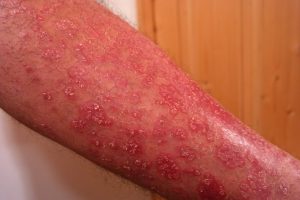 The most common form, plaque psoriasis causes dry, raised, red skin lesions (plaques) covered with silvery scales. The plaques might be itchy or painful and there may be few or many. They can occur anywhere on your body, including your genitals and the soft tissue inside your mouth.
The most common form, plaque psoriasis causes dry, raised, red skin lesions (plaques) covered with silvery scales. The plaques might be itchy or painful and there may be few or many. They can occur anywhere on your body, including your genitals and the soft tissue inside your mouth.
Plaque psoriasis (also known as psoriasis vulgaris ) — This is the most common form of psoriasis, found frequently on the knees, elbows, lower back and as scalp psoriasis. People with scalp psoriasis generally have psoriasis on other areas of their body as well, but this location can be particularly frustrating because it can cause a dandruff-like appearance and may even lead to temporary hair loss.
Plaque psoriasis causes plaques to appear on the surface of the body. The plaques are raised, red patches of skin covered in white or silvery scales.
Plaque psoriasis, like all types of psoriasis, is an autoimmune disorder. Scientists believe that there is a genetic component as it tends to run in families. So, if someone’s parent or sibling has plaque psoriasis, then they are more likely to have psoriasis as well.
Plaque psoriasis is the most common form of psoriasis, a chronic autoimmune disease that causes raised, red, scaly patches covered with silvery scales on the skin. These lesions are known as plaques. Plaques often itch and may be painful. They may appear anywhere on the body, but usually affect the outside of the elbows, knees or scalp. Plaques also develop in skin folds under the arms and breasts.
Plaque psoriasis can appear on any part of the body, but it is most commonly found on the scalp, knees, elbows, and torso. Sometimes the lesions appear as a mirror image on the left and right sides of the body.
Plaque psoriasis is caused by an overactive immune system. Normal skin cells mature and fall off the body in about a month, but the immune system of a person with plaque psoriasis speeds up the skin’s growth cycle, so new skin cells develop in only 3 to 4 days. Instead of falling off, these cells remain on the skin where they form thickened patches (lesions or plaques).
Plaque psoriasis is a lifelong condition that causes thick, scaly, red skin. About 7.5 million adults in America have psoriasis. Plaque psoriasis is the most common form. Some medicines may make your plaque psoriasis get worse.
Plaque psoriasis symptoms may get better or worse without reason. But some events can trigger flare-ups. Stress, skin injuries, infections, or reactions to some medicines are a few things that may make your plaque psoriasis get worse. Plaque psoriasis can cause some complications. The plaques may become infected, especially if they are cracked and bleeding.
Plaque psoriasis occurs worldwide, although its prevalence varies with race, geography, and environmental factors (eg, sun exposure). In the United States, 1-2% of the population has plaque psoriasis.
Plaque psoriasis first appears during 2 peak age ranges. The first peak occurs in persons aged 16-22 years, and the second occurs in persons aged 57-60 years. Females develop plaque psoriasis earlier than males, and patients with a positive family history for psoriasis also tend to have an earlier age of onset.
Treating psoriasis often proves difficult. Respondents report trying plenty of treatment options, but frustration in finding a course that works. Only one in three said they were satisfied with their current treatment plan. Forty percent previously used phototherapy/light therapy, but only 4% currently do. Corticosteroids also show a drop, with 49% previously using verses current usage of 31%. Topical treatments (prescription or over-the counter) show an increase with 36% previously using and 57% currently doing so. The newer biologic medicines are currently used by 26% of respondents.
Laminine Can Help Relieve Plaque Psoriasis…
Watch the Video Below

